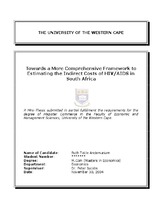| dc.contributor.advisor | Jacobs, Peter Dr. | |
| dc.contributor.author | Andemariam, Ruth Tekle | |
| dc.contributor.other | Faculty of Economics and Management Sciences | |
| dc.date.accessioned | 2013-04-05T14:05:28Z | |
| dc.date.available | 2014-12-31T22:10:06Z | |
| dc.date.issued | 2004 | |
| dc.identifier.uri | http://hdl.handle.net/11394/160 | |
| dc.description | Magister Commercii - MCom | en_US |
| dc.description.abstract | This study proposed a modification of the traditional cost-of-illness approach. It considered additional indirect cost parameters that yield a comprehensive cost structure for human capital at a micro level. Although HIV/AIDS is an epidemiological problem, it has enormous direct and indirect economic costs. Arguably, the most important cost associated with HIV/AIDS results from the high rates of morbidity and mortality among working age adults, the vast majority of those infected. These are essentially losses in an economy's existing stock and potential accumulation of human capital, implying lower levels of labor productivity and eventually loss of labor. These impacts are accounted for in existing macroeconomic and microeconomic impact studies. Indirect costs, such as forgone earnings due to illness, are included whereas forgone earnings of caregivers in the household are unaccounted for. | en_US |
| dc.language.iso | en | en_US |
| dc.publisher | University of the Western Cape | |
| dc.subject | Economic aspects | en_US |
| dc.subject | HIV infections | en_US |
| dc.subject | AIDS (Disease) | en_US |
| dc.subject | HIV (Viruses) | en_US |
| dc.subject | South Africa | en_US |
| dc.title | Towards a more comprehensive framework to estimating the indirect costs of HIV/AIDS in South Africa. | en_US |
| dc.type | Thesis | en_US |
| dc.rights.holder | University of the Western Cape | en_US |
| dc.description.country | South Africa | |

